| |
Label Profile : Erstwhile Records
by Jason Bivins
April 2001
Some 40 years ago, Ornette Coleman famously remarked that he wanted
to play the music, not the background. But what happens when sounds
that are generally dismissed as background—pops, clicks, wheezes,
whines, drones, static, and so forth—are foregrounded, and become
the opening onto new musical vistas and new modes of artistic expression?
Audiences for improvised music these days are, as ever, not especially
large. Those that exist tend to come to the music with a bundle of
expectations: the music, they demand, should be intense, cathartic,
and emotionally expressive in fairly evident ways. Sadly, these expectations
lead many listeners to ignore some of the most intense and involving
improvisation being made these days.
Amongst a small but interlinked bunch of musicians from Europe, New
Zealand, the United States, and elsewhere, the combination of "traditional"
acoustic instruments with electronics (those of the "everyday" sort,
the analogue variety, or those emerging recently in the age of Powerbooks
and G3's) is producing improvised music that demands a rethinking
of expectation and a recalibrating of listening habits. Lofty as this
may sound, this music is as immediate and satisfying as any currently
being made.
At the forefront of this music's documentation is the American label
Erstwhile Records, founded in 1999 by Jon Abbey. After beginning with
three releases from well-known places on the improvisational spectrum
(the trio VHF, Loren Mazzacane Connors' Haunted House group, and the
duet of Earl Howard and Denman Maroney), Abbey's efforts have focused
exclusively on what he calls "the current phase of Erstwhile", devoted
to documenting electro-acoustic improv. Abbey opines that there may
not have been a tremendous amount of accomplished electro-acoustic
improv prior to the late 1990s, so he didn't exactly sense the need
to document a scene that hadn't yet sprung into existence. Once more
of this music came to light, however, Abbey began to focus his label's
efforts squarely on it.
This is a brand of improvisation for which the question "what is jazz?"
is largely irrelevant, despite the fact that, in Abbey's words, "this
mini-genre is the logical extension of free improv, with AMM as a
prime antecedent." Indeed, AMM co-founder Keith Rowe told Abbey that
"for the first time since the sixties, improvisers aren't working
in a post-Coltrane aesthetic, but rather a post-Duchamp one." This
may mean any number of things, depending on one's understanding of
Duchamp, but I take it that Rowe is distinguishing between extensions
of existing techniques or conventions and the wholesale questioning
and problematization of such musical givens.
As the label's statement of intent declares, this music occupies a
"middle ground between improvisation and composition, trained and
self-taught, acoustic and electronic, organization and abstraction".
For Abbey, this in-between space became apparent at an Austrian music
festival curated by Otomo Yoshihide in late 1999. Of that festival,
Otomo opines that "a new stream is emerging in music at the moment.
In contrast to new kinds of music it will not be easily recognized
at first sight. It is the hard work of radically reconsidering the
very nature of music, of listening and performing. In contrast to
new musical styles of the past it will probably neither have a certain
form nor a name." The musical doors in this music are as open to electronica
fans as to improv fans.
This is not to suggest that the use of electronics in contemporary
music-making is anything radically new. It has been ubiquitous in
popular music as well as in "classical" composition and performance
since the 1960s. Composers like John Cage, Pierre Boulez, Morton Subotnick,
Karlheinz Stockhausen, Luc Ferrari, Milton Babbitt, and other leading
lights were early champions of the use of electronics in their search
for new textures and soundscapes. Staunch traditionalists have always
whispered anathemas when theremins, synthesizers, or tone generators
are hauled onstage, but the electronic presence has been a steady
one despite conservative harumphing.
In the world of improvised music, however, the use of electronics
has not been quite so widespread. The British improvising ensemble
AMM (of which Erstwhile recording artist Keith Rowe is a founding
member) has long experimented with the interaction between "traditional"
instruments like saxophone or percussion and spontaneously manipulated
electronics. Their important work opened up new territories in terms
of texture and technique, but also raised important questions about
how musical form should be constructed and perceived: is improvisation
a soloist's art or a collective one? Should improvisations have a
linear, narrative quality, or should they abjure these features? The
collective Musica Electronica Viva was also experimenting with these
instruments, processes, and questions in the 1960s and 1970s (early
exemplars here included Alvin Curran and Richard Teitelbaum, among
others). Thereafter, these early examples began to inspire second-generation
Europeans—represented in the ensembles Nachtluft and Voice Crack—to
use electronics as a means of exploration, communication, and sound
organization.
This type of exploration, at the fringes of an already marginal music,
has been hugely abetted by the advent of widespread, powerful, and
relatively accessible computer-based sound technology. New devices
like the Macintosh G3/4 or PowerBook possess the speed and the memory
necessary to interact with non-computerized instruments in real time,
thus eliminating some of the hindrances typically faced by electronics
practitioners in the past.
These developments have been widely noted. But, aside from the electronics
experiments of well-known players like Evan Parker or Phil Wachsmann,
this new music is only now beginning to receive proper attention.
Enter Jon Abbey, a longtime fan of this music who has taken it upon
himself to document much of this scene and its most important creators.
One of the problems seemingly facing record labels and listeners is
that this music seems to resist easy classification. Not only do its
practitioners come from diverse backgrounds like rock (Jim O'Rourke,
Otomo Yoshihide or Fennesz), "classical" new music (Burkhard Stangl),
or free improvisation (Gunter Muller, John Butcher, or Keith Rowe),
but the music itself does not have a name yet. It has been called
(rather generically) electro-acoustic improvisation, microvisation,
dangerous improv, and more.
Having now digested much of Erstwhile's catalogue, I believe that
this is a music perfectly suited to the blurring and even collapse
of musical boundaries seen in improvisation for some time now. To
me, this is a sign of overall health in the music. "Free improvisation"
is now so often riddled with cliches (saxophonists absently filling
spaces by clicking on pads, or pianists diving quickly for the strings
inside) and it has generated a species of defenders whose zeal for
Ayler-era blowing is as intense as that of the Marsalisites for New
Orleans music. But there is tremendous creativity and energy amongst
improvisors, much of it not limited to jazz-based communities. And
this is where the importance of documentation comes in.
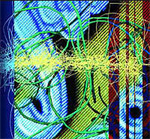 One
of the joys of listening to Erstwhile's releases is in digging deeper
into the work of seldom-documented artists like German analogue synthesizer
player Thomas Lehn. He is part of the important scene in Cologne,
but his work has not been recorded much. Rarely, if ever, has there
been a more visceral synth player (as anyone who's seen Lehn live
can attest). This energy suffuses one of Erstwhile's early gems, Lehn's
summit meeting with omni-percussionist Gerry Hemingway on Tom &
Gerry. Hemingway has long incorporated electronics in his solo
performance and is well calibrated to the range of sounds that can
emerge from those situations. On their June 1997 duo tour, the two
went at it night after night, resulting in a hugely involving two
discs of music. One
of the joys of listening to Erstwhile's releases is in digging deeper
into the work of seldom-documented artists like German analogue synthesizer
player Thomas Lehn. He is part of the important scene in Cologne,
but his work has not been recorded much. Rarely, if ever, has there
been a more visceral synth player (as anyone who's seen Lehn live
can attest). This energy suffuses one of Erstwhile's early gems, Lehn's
summit meeting with omni-percussionist Gerry Hemingway on Tom &
Gerry. Hemingway has long incorporated electronics in his solo
performance and is well calibrated to the range of sounds that can
emerge from those situations. On their June 1997 duo tour, the two
went at it night after night, resulting in a hugely involving two
discs of music.
As a musician and improvisor, Lehn is peerless across these duets.
He is able to marshal the vast sonic resources of his instrument,
making split-second decisions, reactions, and creations that both
challenge and respond to Hemingway. Despite its associations, the
synthesizer isn't unwieldy or excessively abstract here. In Lehn's
hands, it becomes quite elegant, even as he makes it spit, bubble,
fart, and moan. The range of his imagination and the intelligence
of his playing are very impressive; I can't fathom how quickly he
follows Hemingway's woodblock and boxy sounds on "B1.1", which Lehn
helps to turn into a sort of clacking symphony. Hemingway is as masterful
as ever, playing here in a less obviously pulse-driven way than many
are accustomed to from him (listen to his amazing solo at the beginning
of "W7"). Bowed cymbals, delicately stroked drum heads, or fierce
crashes are used to flesh out the shapes thrown at him by Lehn. "W2"
is a phenomenal accretion of sound, building slowly from scrapes and
hisses to a fantastic barrage. Hemingway leads things splendidly at
times, as he does on "W3," exemplifying this equal exchange
of sound, texture, pleasure. "W5.2" is very solemn, almost like a
processional. Fierce stuff, an essential duo.
 Even more
out is the synth showdown on BART, where Lehn matches his electronic
prowess with digital synthesizer and computer maestro Marcus Schmickler.
Schmickler's improvisational background is not as extensive as Lehn's,
the former having honed his skills primarily in studio production.
But the two met in Keith Rowe's Music in Movement Electronic Orchestra
and began collaborating frequently on improvisations. Even more
out is the synth showdown on BART, where Lehn matches his electronic
prowess with digital synthesizer and computer maestro Marcus Schmickler.
Schmickler's improvisational background is not as extensive as Lehn's,
the former having honed his skills primarily in studio production.
But the two met in Keith Rowe's Music in Movement Electronic Orchestra
and began collaborating frequently on improvisations.
On this first recorded meeting, the listener is drawn into a world
of alien tonality, sine waves, eruptions of static and noise, and
washes of almost elemental sound. There is a huge amount of energy
both in the production of the sounds themselves and in the interaction;
for anyone who thought that electronics were not visceral or powerful,
BART is your corrective. But one of the things that makes this
recording so compelling is the post-production brought to it, where
the performances are edited and (more frequently) the details highlighted
and the sound-field embellished to put all the detail in relief (often
resulting in tremendous headphone effects like you'd get listening
to a David Slusser recording).
Certainly this process-oriented improvisation is not linear or conventionally
expressivist. But don't be fooled by the bleeps and whirrs and sproings—this
music contains a wealth of the basic elements that improv fans love:
responsiveness, attention to detail, pushing the envelope, and a pioneering
of new instrumental techniques. The role of chance governs things
just as surely as on, say, an Evan Parker record; but here the instrumentation
enables the creation of sonic environments that challenge the musicians
to respond with new gestures, new vocabularies, and new strategies.
The massive flatulence that begins "Ziege" may sound like an army
of computers crashing at the same time, but make no mistake—human
intentionality, communication, and decision-making went into this
stuff live and in the moment. It's a cyclone of sound, as intoxicating
as any improvisation being made. And "OS" is a gentle tonic of wave
forms and drones before the exhausting and very rich journey of "Du
Funktion". This is total music, which challenges trite notions of
virtuosity and instrumental individualism. Instead, the music on BART
is realized in a different manner. The relationship between sound
and silence is paramount, and musical gestures are measured according
to how they affect the overall sound environment (as would a ripple
on a pond).
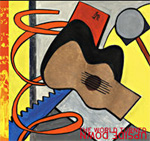 In
addition to documenting Lehn, another strength of the Erstwhile catalogue
is its attention to guitarists at the vanguard of contemporary music.
Six-stringers who generally fall outside the post-Coltrane lineage
of expressionism are more than likely influenced by AMM member Keith
Rowe. On one of the strongest releases, Rowe himself joins Swiss percussionist/electronics
manipulator Gunter Muller and fellow guitarist Taku Sugimoto on The
World Turned Upside Down. Over the course of two long and quite
spacious improvisations, this trio creates a sonic dreamworld of subtle
timbral and textural variations, slight oscillations, and floating
waves of electricity. Amazingly, Muller and Rowe are able to coax
from the simplest sonic elements (the hum of a static, the contact
between wires, feedback) a momentum and form that, while unconventional,
is strangely inviting. Instead of focusing on brief linear expressions,
the music centers around subtle and often very rapid shifts in color
and shading. The distinction between foreground and background becomes
blurred, even as Sugimoto strums and arpeggiates gently amidst the
burble. In
addition to documenting Lehn, another strength of the Erstwhile catalogue
is its attention to guitarists at the vanguard of contemporary music.
Six-stringers who generally fall outside the post-Coltrane lineage
of expressionism are more than likely influenced by AMM member Keith
Rowe. On one of the strongest releases, Rowe himself joins Swiss percussionist/electronics
manipulator Gunter Muller and fellow guitarist Taku Sugimoto on The
World Turned Upside Down. Over the course of two long and quite
spacious improvisations, this trio creates a sonic dreamworld of subtle
timbral and textural variations, slight oscillations, and floating
waves of electricity. Amazingly, Muller and Rowe are able to coax
from the simplest sonic elements (the hum of a static, the contact
between wires, feedback) a momentum and form that, while unconventional,
is strangely inviting. Instead of focusing on brief linear expressions,
the music centers around subtle and often very rapid shifts in color
and shading. The distinction between foreground and background becomes
blurred, even as Sugimoto strums and arpeggiates gently amidst the
burble.
Documented live at the Paris club Les Instants Chavires, this first-time
meeting of the trio is a hypnotic hour-long fantasy. The aural effect
is similar to that of having woken from a very affecting dream, the
specifics of which you cannot remember. No distinct events or episodes
stand out, yet the experience shifts your perception of things nonetheless.
At times, this trio music may sound like the electric equivalent of
a babbling brook or rustling leaves, so elemental are its charms;
but essentially, it defies language's ability to fix and capture it.
A triumph.
 Kevin
Drumm certainly operates at the fringes of guitar technique like Rowe.
But Drumm, like his duo partner Martin Tetreault, is an altogether
crankier presence. Fussing and bothering his tabletop instrument with
devices and preparations, Drumm does not work in terms of any recognizable
process or flow; rather he constructs what might be heard as an elaborate
series of interruptions: crackles, warbles, buzzes, and pops. But
what are they interrupting? Certainly Tetreault's use of turntables
(already anathema to many free jazz purists) is not of the obvious
sort; there is no scratching or mixing, only the raw sound of an instrument
being manipulated. Other writers have compared Particles and Smears
to a Schwitters collage or a Cage exercise—these comparisons
aren't altogether off-base, as they call attention to Drumm's and
Tetreault's incorporation of chance into their creations. Kevin
Drumm certainly operates at the fringes of guitar technique like Rowe.
But Drumm, like his duo partner Martin Tetreault, is an altogether
crankier presence. Fussing and bothering his tabletop instrument with
devices and preparations, Drumm does not work in terms of any recognizable
process or flow; rather he constructs what might be heard as an elaborate
series of interruptions: crackles, warbles, buzzes, and pops. But
what are they interrupting? Certainly Tetreault's use of turntables
(already anathema to many free jazz purists) is not of the obvious
sort; there is no scratching or mixing, only the raw sound of an instrument
being manipulated. Other writers have compared Particles and Smears
to a Schwitters collage or a Cage exercise—these comparisons
aren't altogether off-base, as they call attention to Drumm's and
Tetreault's incorporation of chance into their creations.
You can almost hear them focus on each lone sound rising from their
ghostly landscape—a tendril of electricity snakes out, a hiss
wafts through the speaker, a glint of metal surfaces at the edges.
"8", for example, sounds like rustling paper and short-wave radio,
interrupted by sounds of worried strings and occasional snippets of
dialogue or noise from the turntable. And "10" is a dizzying avalanche
of sound which begins almost imperceptibly and soon comes to surround
you. It is almost as if, out of this apparently random succession
of noise, Drumm and Tetreault elaborate their own musical code, which
conveys to the listener its most alien qualities. But each (non-)event
is carefully allowed to develop, considered for its impact, then abandoned.
Its significance is registered, but ultimately lost in the sounds
or silences which follow.
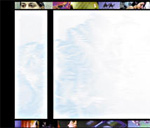 On Schnee,
Viennese heavies Burkhard Stangl (known for his collaborations with
Polwechsel and Franz Koglmann, among others) and Christof Kurzmann
(collaborator with Jim O'Rourke, Christian Fennesz, Kevin Drumm, and
others) unite in the creation of the sparsest, most delicate release
in the Erstwhile catalogue. It is also perhaps the most beguiling.
With his G3, Kurzmann creates soundscapes of both stillness and motion,
their subtle fluctuations operating on both the conscious and subconscious
levels. There is no attempt to "play"; rather, the two focus their
four creations on evocation. It is as if Kurzmann were providing the
paper and Stangl the brush, careful to choose only as many strokes
as needed to produce a work of simplicity and power. A single note
from an acoustic guitar rings out against a hazy tableau, or a lone
liquid chord shapes the inchoate language pouring out of Kurzmann's
instrument. Prepare yourself for beauty, for lonely sounds at home
in a sonic landscape both remote and inviting. Acoustic and electric
music mesh together perfectly here in a minimalist dialogue that grows
in significance with each listen. On Schnee,
Viennese heavies Burkhard Stangl (known for his collaborations with
Polwechsel and Franz Koglmann, among others) and Christof Kurzmann
(collaborator with Jim O'Rourke, Christian Fennesz, Kevin Drumm, and
others) unite in the creation of the sparsest, most delicate release
in the Erstwhile catalogue. It is also perhaps the most beguiling.
With his G3, Kurzmann creates soundscapes of both stillness and motion,
their subtle fluctuations operating on both the conscious and subconscious
levels. There is no attempt to "play"; rather, the two focus their
four creations on evocation. It is as if Kurzmann were providing the
paper and Stangl the brush, careful to choose only as many strokes
as needed to produce a work of simplicity and power. A single note
from an acoustic guitar rings out against a hazy tableau, or a lone
liquid chord shapes the inchoate language pouring out of Kurzmann's
instrument. Prepare yourself for beauty, for lonely sounds at home
in a sonic landscape both remote and inviting. Acoustic and electric
music mesh together perfectly here in a minimalist dialogue that grows
in significance with each listen.
 On
the fourth guitar-oriented release, the two long tracks are somewhat
improbably entitled "Rock and Roll, parts 4 & 5". What is it that
we love about rock and roll? Volume? Histrionics? Or the power of
minimalism? New Zealander Dean Roberts, longtime investigator of drone-based
music, teams up with multi-instrumentalist Werner Dafeldecker (of
Polwechsel, among others). Though from slightly different musical
backgrounds, as with many Erstwhile collaborators, the two find common
ground in a devotion to long-form process. Out of a very long studio
session, their collaboration resulted in Aluminium, a tour
de force for guitar and electronics. On
the fourth guitar-oriented release, the two long tracks are somewhat
improbably entitled "Rock and Roll, parts 4 & 5". What is it that
we love about rock and roll? Volume? Histrionics? Or the power of
minimalism? New Zealander Dean Roberts, longtime investigator of drone-based
music, teams up with multi-instrumentalist Werner Dafeldecker (of
Polwechsel, among others). Though from slightly different musical
backgrounds, as with many Erstwhile collaborators, the two find common
ground in a devotion to long-form process. Out of a very long studio
session, their collaboration resulted in Aluminium, a tour
de force for guitar and electronics.
On these two long pieces, there is considerable tension generated
from the most basic musical materials. Sine waves and liquid coils
of feedback float ominously across the sound spectrum, suggesting
a gathering storm of some sort. Certainly the atmospherics are dense,
but there is also considerable light emerging from the clouds as well.
With a diverse array of resources at their disposal—drones,
shape-shifting feedback masses, scrapes, whines, and pitch-shifts—the
two guitarists explore a hidden world of contrasts and contours. There
are great clangorous noises throughout, sounding like chains being
dragged across a metal surface, but also barely audible hissing. Out
of it all comes a carefully constructed sound environment, using subtle
fluctuations of dynamics and timbre to negotiate space. Rock and roll?
More like metallurgy.
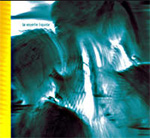 Two
recent entries in the Erstwhile catalogue come from real veteran practitioners
of the electronic arts. Both Günter Müller and Lê Quan Ninh are trained
as percussionists but have steadily developed their approaches to
music in conjunction with electronics. Muller's For 4 Ears label has
assiduously documented his own progress as an improvisor as well as
projects undertaken by like-minded musicians (including those who
join together on Bits, Bots & Signs). These are two musicians
who truly understand the languages and possibilities in percussion—not
just as rhythmic generators but as sound devices. Think Xenakis and
Cage, and you begin to get the idea. Of all the Erstwhile releases,
La Voyelle Liquide sounds the most "natural", the most "organic",
though these very categories become problematic the deeper I engage
this music. Two
recent entries in the Erstwhile catalogue come from real veteran practitioners
of the electronic arts. Both Günter Müller and Lê Quan Ninh are trained
as percussionists but have steadily developed their approaches to
music in conjunction with electronics. Muller's For 4 Ears label has
assiduously documented his own progress as an improvisor as well as
projects undertaken by like-minded musicians (including those who
join together on Bits, Bots & Signs). These are two musicians
who truly understand the languages and possibilities in percussion—not
just as rhythmic generators but as sound devices. Think Xenakis and
Cage, and you begin to get the idea. Of all the Erstwhile releases,
La Voyelle Liquide sounds the most "natural", the most "organic",
though these very categories become problematic the deeper I engage
this music.
The combination of Ninh's surrounded bass drum, with its huge reverberation,
and the electronics produce an aural effect of great mass and magnitude.
The groaning and heaving noises suggest some unknown acts of nature,
while the slashing sounds they generate sound like rain sheets or
warping metal. Amidst all this, however, there is delicacy as well:
trinkling bell noises, soft blowing winds, and tiny rustles command
the attention outside of the larger gestures. These two percussionists
are unfailingly compelling just as musicians; they use their resources
and instruments in the most daring of ways, conjuring up a wide array
of colors and feelings in the open territory they inhabit. I felt
that I was hearing the flow of my own subconscious.
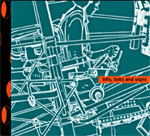 Listening
to Bits, Bots & Signs, it seemed to me as if Otomo Yoshihide
is incapable of making a less than absorbing recording. Many listeners
know his work from the joyous bombast of Ground Zero. But of late,
Otomo has turned his attention to a more minimalist idiom (listen
to Filament or I.S.O.), often using the sine waves associated with
frequent collaborator Sachiko M. As on the classic "Consume Red",
Otomo has become interested in the slow and subtle manipulation of
a basic and continuous element of sound. Instead of working with song
forms, Otomo's method is akin to the construction of musical space
itself, the fashioning of a sonic environment which dictates its own
norms and conventions. It's natural, then, that he should eventually
collaborate with the Swiss duo Voice Crack (also known as Norbert
Moslang and Andy Guhl), whose use of "cracked everyday-electronics"
has taken them into similar territories since the early 1980s. Listening
to Bits, Bots & Signs, it seemed to me as if Otomo Yoshihide
is incapable of making a less than absorbing recording. Many listeners
know his work from the joyous bombast of Ground Zero. But of late,
Otomo has turned his attention to a more minimalist idiom (listen
to Filament or I.S.O.), often using the sine waves associated with
frequent collaborator Sachiko M. As on the classic "Consume Red",
Otomo has become interested in the slow and subtle manipulation of
a basic and continuous element of sound. Instead of working with song
forms, Otomo's method is akin to the construction of musical space
itself, the fashioning of a sonic environment which dictates its own
norms and conventions. It's natural, then, that he should eventually
collaborate with the Swiss duo Voice Crack (also known as Norbert
Moslang and Andy Guhl), whose use of "cracked everyday-electronics"
has taken them into similar territories since the early 1980s.
These five improvisations conjure up a world made of metal and electricity,
where huge tectonic plates shift mightily ("@@@4") beneath a sky filled
with comets and humming with energy. If you listen, you'll find traces
of sounds familiar to you: factory noises cranking out their repetitive
tattoo, car engines sputtering on a cold morning, cicadas whining,
or coffee grinders whirring away. But there are also less familiar
noises: the long, mesmerizing tones being subtly transformed over
several minutes, or the sounds I imagine I might hear inside a shipwreck
on the ocean floor. Fundamentally, these soundscapes beggar the language;
this music is sui generis. But what a joy to have so many new images—both
troubling and pleasing—brought to life through improvisations.
For those who think they've heard it all before, listen to this.
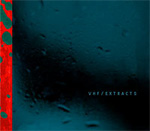 Finally,
there are two projects involving "traditional" improvising instruments
(notably the saxophone) and featuring improvisors well known to listeners
from contexts other than electro-acoustic improv. In the spacious
and occasionally haunting work of VHF (Graham Halliwell, Simon H.
Fell, and Simon Vincent), the process-oriented, "laminal" approach
of AMM is a fairly good touchstone. Though this trio incorporates
the smallest amount of electronics of any other release, it is similar
in method to other projects. Rather than concentrating on "events"
or "expressions", the trio instead focus on particular musical resources
(such as attack or dynamics) or specific instrumental properties as
bases for their collective creations. For example, Fell is able to
wring the most liquid of drones from his contrabass (he gets an impossibly
low rumble on "Ra"), and Halliwell the grainiest multiphonics from
his saxophone, spreading them slowly across the tone-field like ink
on paper. Cymbals swell, creating tension and release while single
notes are held. The quiet bustle of the drum kit creates an aural
environment on "Tr", "Ct" and "Ac", all of which hum with quiet vitality,
shaped by the subtle gestures of breath through reed or stroke of
strings. The dynamics are intense, and the music on Extracts
is very advanced. Finally,
there are two projects involving "traditional" improvising instruments
(notably the saxophone) and featuring improvisors well known to listeners
from contexts other than electro-acoustic improv. In the spacious
and occasionally haunting work of VHF (Graham Halliwell, Simon H.
Fell, and Simon Vincent), the process-oriented, "laminal" approach
of AMM is a fairly good touchstone. Though this trio incorporates
the smallest amount of electronics of any other release, it is similar
in method to other projects. Rather than concentrating on "events"
or "expressions", the trio instead focus on particular musical resources
(such as attack or dynamics) or specific instrumental properties as
bases for their collective creations. For example, Fell is able to
wring the most liquid of drones from his contrabass (he gets an impossibly
low rumble on "Ra"), and Halliwell the grainiest multiphonics from
his saxophone, spreading them slowly across the tone-field like ink
on paper. Cymbals swell, creating tension and release while single
notes are held. The quiet bustle of the drum kit creates an aural
environment on "Tr", "Ct" and "Ac", all of which hum with quiet vitality,
shaped by the subtle gestures of breath through reed or stroke of
strings. The dynamics are intense, and the music on Extracts
is very advanced.
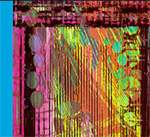 Requests
and Antisongs is an extraordinary recording by any standard. Duo
partners Butcher and Durrant are longtime collaborators, familiar
to most fans of improvised music for their work together in SME as
well as their long-standing trio with guitarist John Russell. In the
last few years, however, Durrant's growing devotion to electronics
has resulted in the formation of one of the most challenging duos
in the music (already documented on a fine Wobbly Rail release). Here
Durrant lays down his violin and uses electronics and feedback to
manipulate Butcher's sax playing in real-time. Occasionally, the electronics
are triggered by Butcher's playing (such as on miniatures like "Jansik").
Elsewhere, one can hear Durrant shaping and reshaping the saxophonist's
lines: the howling data storm of "Sheet Bend", the extreme squealing
and squelching of "Kreuzklem" (Durrant's most incredible performance,
to me), or the cloudy "Prusik Loop". Requests
and Antisongs is an extraordinary recording by any standard. Duo
partners Butcher and Durrant are longtime collaborators, familiar
to most fans of improvised music for their work together in SME as
well as their long-standing trio with guitarist John Russell. In the
last few years, however, Durrant's growing devotion to electronics
has resulted in the formation of one of the most challenging duos
in the music (already documented on a fine Wobbly Rail release). Here
Durrant lays down his violin and uses electronics and feedback to
manipulate Butcher's sax playing in real-time. Occasionally, the electronics
are triggered by Butcher's playing (such as on miniatures like "Jansik").
Elsewhere, one can hear Durrant shaping and reshaping the saxophonist's
lines: the howling data storm of "Sheet Bend", the extreme squealing
and squelching of "Kreuzklem" (Durrant's most incredible performance,
to me), or the cloudy "Prusik Loop".
What makes this so wild is that Butcher's saxophone playing is itself
so compellingly strange, so alien (even relative to a tradition which
values radical experimentation). The buzzing and fluttering sounds
he produces from his tenor and soprano already sound like ghost versions
of a saxophone; so when Durrant begins spitting back shadow sounds
that hover close to Butcher's own, the effects are doubly (or triply?)
eerie. Just listen to the riot of multiphonics on "Sliding Chinese
Crown" or the chorus of chirps on "Flemish Eye". And a piece like
"Bimini", which sounds so tranquil on its surface, reveals ever deeper
layers of disquiet on repeated listenings. This fabulous duo goes
from strength to strength on this recording, which should be dug promptly
by anyone interested in where contemporary improv is going.
By the time this article sees print, Erstwhile will have continued
its own voyages with a pair of great looking new releases: do
(013) featuring Toshimaru Nakamura and Sachiko M, and dach
(014) with Durrant, Lehn, and Radu Malfatti. Upcoming in early spring
are a duo with Axel Dörner and Kevin Drumm (015) and We Are Everyone
In the Room (016) with Stilluppsteypa and TV Pow.
Needless to say, I enthusiastically recommend all the above releases.
It's been my genuine pleasure to live with this music for a while,
to let it sink into my pores, to have it accompany me in my daily
routines. Certainly, the pleasures of the releases are immediate—there
is great improvisation, pure and simple, and the sounds are compelling
in their own right. But deeper still, this is music that has transformed
my listening habits more broadly, that has slowly but perceptibly
shifted the categories I generally use when evaluating music. Jon
Abbey confesses that he no longer quite knows what to call the music
he documents with his label. I certainly am hesitant to put forth
a candidate (though I returned again and again to the title of an
AMM album, The Nameless Uncarved Block). Perhaps this resistance
to naming is important to the music, though. Its lasting pleasures
are many, but none richer for me than its persistent elusiveness in
the face of my descriptions. The music is alive, protean, and wonderfully
multiple.
|
|
|
|
|

